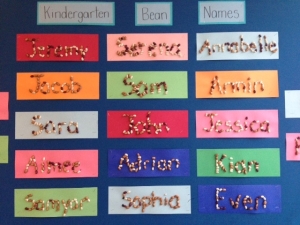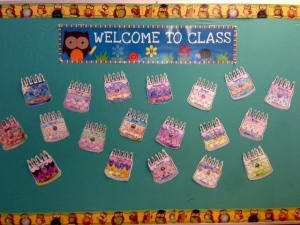
snack and lunches should be packed in a food bag
This week we completed our first week in the full day Kindergarten program. One of the most important things we do in a full day, compared to the half day program, is have your children eat lunch at school.
After many years of watching children each lunch in our classrooms, there’s one thing we know very well: eating at school can be a complex, social affair.
In terms of the children’s self-regulation, eating is calming. If the children are tired and running low on fuel, a snack is often what they need to help them up-regulate from the blue zone to the green zone. When the children sit down to eat after a busy morning of learning, eating at lunch to fill up hungry tummies is just the thing they need to stay relaxed, calm and focused for the next part of the afternoon. In these early weeks of September, we have a “last snack” time for the children around 2:35 before we dismiss at 2:55 pm. Most of the children partake of a few pieces of fruit or crackers, or the last bites of a sandwich, and everyone wants long drinks of water to help them rehydrate.
When students eat snack and lunch at school, the social dynamics are very different than eating at home, or even in a restaurant. We try to set up a calm, self-regulated environment for eating: quiet music is playing in the background, the lights are turned down low and there’s the initial quiet as children are settling down to eat. There will be some quiet conversation and even a bit of laughter. But the expectation is that the children know and remember that their job at that time is to refuel first, then go outside to play.

a great idea to label snack containers in the food bag
At the tables, there is not typically an adult who sits down beside students to assist or cajole them to eat. At school, even in Kindergarten, the children have to be able to eat independently which includes using a spoon or fork. We have an adult lunchtime supervisor and Grade 7 monitors (who need to eat their own lunches) to help children with opening tight lids and or well sealed packages. We will not, and cannot, make a child eat. There is no negotiating, but we might give a gentle reminder: “eat one more bite,” “two more mouthfuls” or “finish half your sandwich.” So if your child is bringing home uneaten food, please know we have tried our very best.
As expected, the children are talking with their seatmates during eating times. However, if there is too much talk then there is not enough eating. The children are very eager to go outside to play on the playground, but our expectation is that a “reasonable amount” of food is consumed before going outside. As teachers and moms of teenagers, we have a lot of experience dealing with kids and food and a pretty good idea of how much each child should eat to sustain his or her energy.
Eating in multicultural classrooms such as ours, where many different kinds of foods are brought to school, is a wonderful, global experience for everyone. This year, your child can be sitting at a table of four where all four children are eating the food specific to their home country! You can imagine how delicious it might look and smell in our rooms. Some children are naturally very curious to try each other’s food, or wish to share their own, but we have reminded our students there is to be no sharing of food. We are “nut aware” classrooms and as allergies can be known and unknown, we do not wish to take any risks of an allergic reaction. You can help us by reinforcing this important message at home.
Preparing Snacks and Lunch at Home
After years of preparing lunches for our own children, and teaching many Kindergarten classes, we know that pleasing the particular and somewhat discerning five-year old palate, is not easy.
For the most part, we know the children are more than content to eat home prepared food. They love to tell us if they are eating last night’s leftovers, or that their mom or dad got up early to prepare a favourite meal for them. We love it when children bring food from home because most times they would have eaten at home first and are confident they will still like the taste at school.
Snacks are easy. The children are often very satisfied with their yogurt, sliced fruit or veggies or small sweet treat such as a cookie, to go alongside their healthy food options. Snacks are easy to present in a finger food format. There are also many ways to purchase snack food that is manageable for children; for example, the “100 calorie” food packages of crackers or cookies, “cheesestrings,” small fruit cups and containers of yogurt (please remember to send a spoon for yogurt and fruit cups). Healthy, fun food can go into a small, reusable containers such as popcorn, fish crackers, cucumber slices, olives and pickles or a fruity muffin. Hummus is a great dip for veggie sticks.

a great assortment of healthy and fun food for snack time
For beverages, we prefer the children drink water from their non-spill water bottles. Fruit juices, while sweet and tasty, are very sugary and spilled juices on the carpet and floors bring the inevitable ants to our classrooms. Fruit juice boxes also create a lot of garbage. We have access to taps and water bottle fillers to refill so fresh, cold water is always available. Please send a water bottle everyday; it’s much cleaner for your child to drink from their own water bottle than use the water fountain, no matter how careful they are when drinking from it.
Eating lunch can be just as fun as snack time. Again, a finger food format for presenting your child’s lunch is very appealing to them. Last week we saw delicious wraps and sandwiches, made with special breads or buns and fillings, emerging from your child’s lunch bag. When your children see this lovingly prepared food, cut into small quarters or halves just right for small hands, it’s like they are eating at a picnic or tea party, and how fun is that? We see yummy slices of cold pizza, quesadillas, bagels and creamcheese, slices of meats, cheese and crackers that we know are very appreciated. You can make eating time easier for your child by simply cutting your child’s food into small, manageable pieces for them to eat, such as a sandwich cut into halves or triangles. Thank you to everyone for using reusable containers and bags for your child’s food, and for sending along a ziploc to catch the garbage in so we can send it home.

a ziploc bag is helpful to collect food packaging
Sometimes the children want a warm lunch and a small thermos of soup, pasta or last night’s rice casserole are great options. You can help us by remembering that when you place the lid on a hot container of food, it creates a strong seal which we often cannot open ourselves. Please allow the food to cool for a minute or two to make the seal less strong. As well, if your child is eating rice, a spoon is a better utensil to send to school as it can be tricky to use a fork because the rice always falls off.
Hot Lunch Program
This coming week begins a shift in our eating experience at school with the advent of the Hot Lunch Program starting on Monday. This program, albeit very convenient, is not always met with the same enthusiasm by the child once he or she begins to eat. “It doesn’t taste right,” is a phrase we have heard many, many times. We encourage you to send along some extra food in your children’s lunch bags, in case they do not like their ordered lunch, until you know for certain that they will eat it. We will let you know in a few weeks time what is popular and well-eaten by our classes. All children must still bring snacks and water to school, even if they order a hot lunch. It’s too long for a child to go from breakfast to lunch without anything to eat. A hungry child is a child who is not self-regulated and without self-regulation, will have difficulty focusing and learning.
Finally, the hot lunch program creates some garbage. Your child should bring their lunch bag and/or a large ziploc bag to contain the garbage and leftover food which we will be sending home, except for frozen treats or anything with a lot of liquid. We will dispose of what we can at school and send the rest home with your child.


















